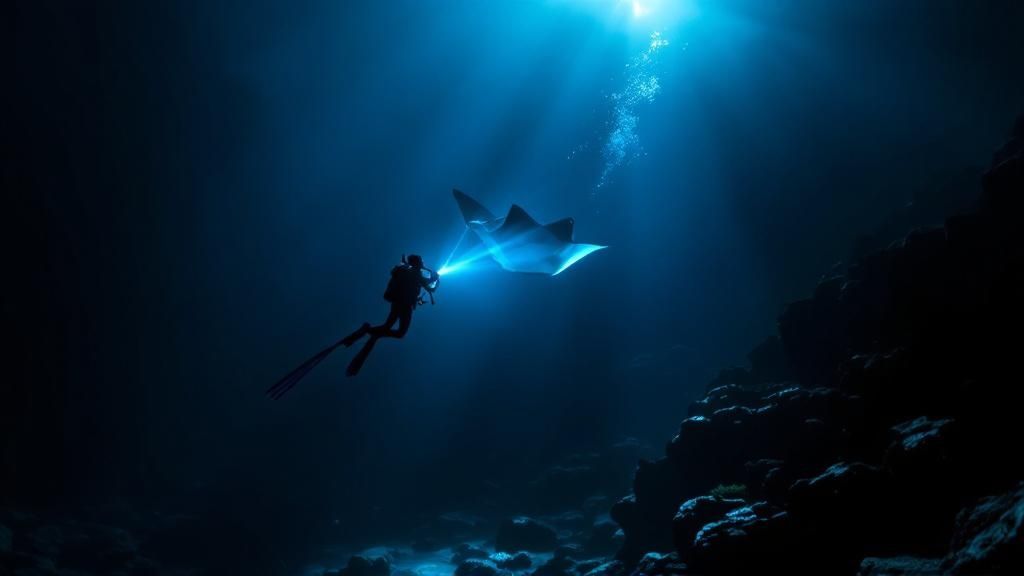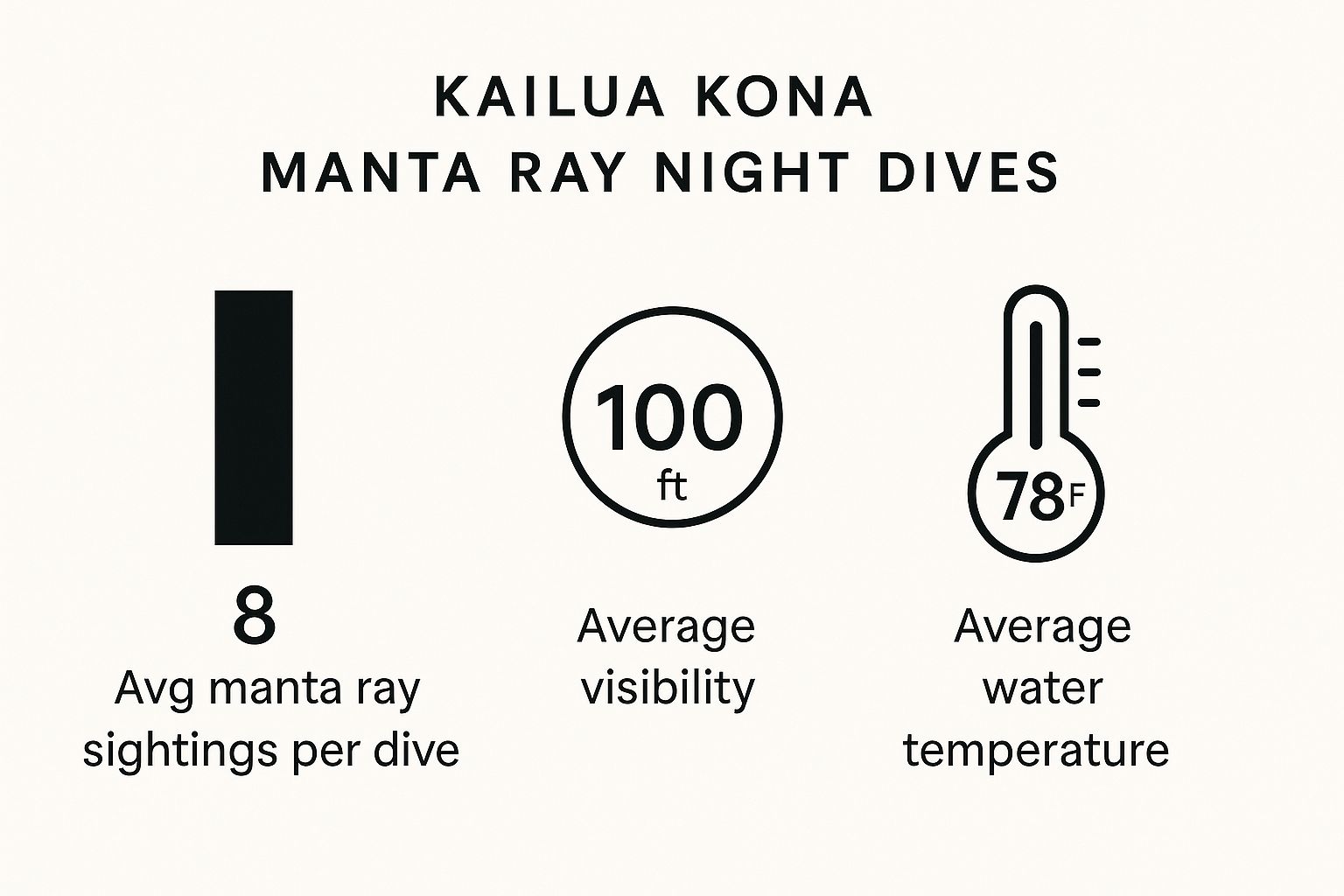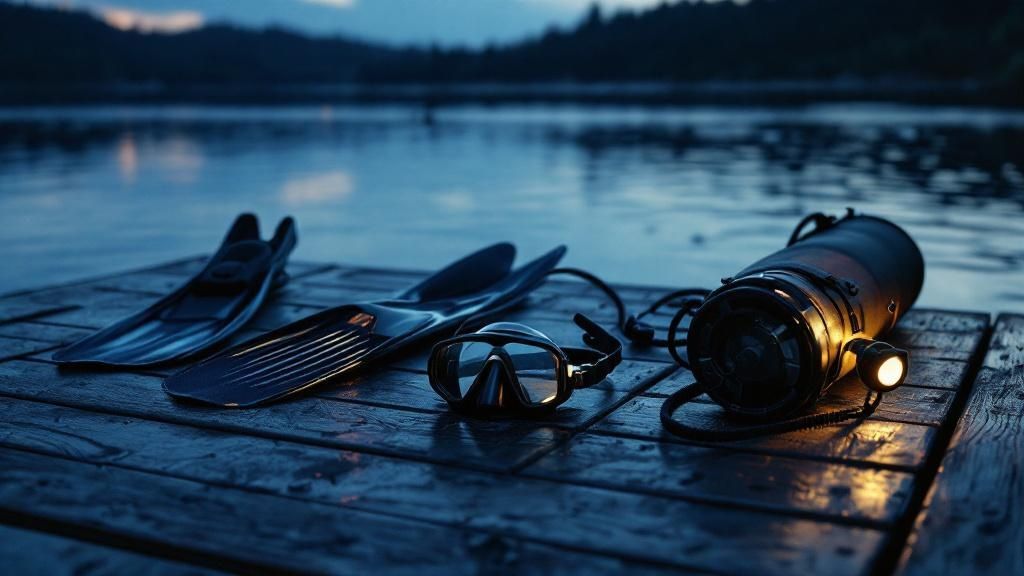Why Kona Is The World's Premier Manta Ray Diving Destination
Kailua Kona, Hawaii, isn't just a stunning vacation destination; it's the place to be for manta ray night dives. This isn't by chance. A unique combination of geological features and ocean currents creates the perfect environment, attracting these gentle giants. The volcanic coastline shapes the underwater currents, concentrating nutrient-rich waters. This, in turn, fuels the growth of plankton, the main food source for manta rays.
This reliable food supply, combined with protected bays that serve as natural feeding grounds, explains the frequent manta ray sightings. The interplay of Hawaii's deep ocean channels and shallow reef systems further enhances this. These reefs offer cleaning stations, where smaller fish remove parasites from the mantas, adding to Kona's appeal as a manta ray haven.
Kona's specific water temperatures and current patterns are also highly favorable for these magnificent creatures. These factors create ideal conditions for plankton blooms, essentially a dinner bell for manta rays. This leads to remarkably high sighting rates. Kona boasts an average sighting rate of 85-90% on manta ray night dives. This impressive statistic highlights Kona as a premier location for these unforgettable encounters. Find more detailed statistics here.
Understanding Kona's Underwater Ecosystem
The volcanic slopes and underwater landscape of Kona play a vital role in concentrating plankton. Certain areas, known as Manta Village and Manta Heaven, act like natural funnels, bringing plankton closer to the surface. This predictable food supply makes these spots perfect for manta ray viewing. What is a manta ray night dive?

To enhance your planning, consider incorporating captivating visuals using LED panel technology to complement the manta ray experience. Kona provides a truly unique and reliable opportunity to witness these graceful creatures in their natural environment. What it's like to go on a manta ray night dive in Kona, Hawaii
Manta Village Vs Manta Heaven: Choosing Your Perfect Dive Site
Deciding between Kona's two famed manta ray night dive sites, Manta Village and Manta Heaven, can be tricky. Both offer incredible encounters, but each location has its own unique characteristics that cater to different divers. Choosing the right site is key to a truly magical manta ray experience in Kailua Kona.
Depth, Topography, and Manta Behavior
South of Kona, Manta Village is known for its shallow depth and sandy bottom. This makes it perfect for newer divers or those looking for a more relaxed dive. The mantas here gather around cleaning stations, providing captivating views of their interactions with cleaner fish.
Manta Heaven, north of Kona, is a bit deeper with more complex coral formations. This site often attracts large groups of manta rays engaged in dynamic feeding behaviors. Experienced divers looking for more active manta interactions may prefer this location. However, both sites offer amazing chances to see these gentle giants up close.
Dive Conditions and Group Size
The best diving conditions at both locations are typically during the calmer summer months. Visibility often exceeds 100 feet, making for spectacular viewing. Responsible operators enforce group size limitations, further improving the experience. Check out the infographic below for a visual overview of typical dive conditions.

This infographic highlights key data for manta ray night dives in Kailua Kona. On average, divers can expect to see 8 manta rays per dive, with 100 feet visibility and an average water temperature of 78°F. These consistent conditions, coupled with the site-specific characteristics, make Kona a prime manta ray diving destination.
To help you make the best decision, let's look at a detailed comparison of Manta Village and Manta Heaven.
To help you choose the perfect dive site, we've compiled a side-by-side comparison of Manta Village and Manta Heaven. This table outlines the key differences and similarities, including depth, experience level recommendations, and unique features of each location.
| Feature | Manta Village | Manta Heaven |
|---|---|---|
| Depth | Shallow | Deeper |
| Experience Level | Beginner-friendly | More suited for experienced divers |
| Topography | Sandy bottom | Coral formations |
| Manta Behavior | Cleaning station interactions | Dynamic feeding behaviors |
| Group Size | Limited for better viewing | Limited for better viewing |
| Typical Visibility | >100ft | >100ft |
As you can see, both sites offer unique advantages. Manta Village provides a more relaxed, beginner-friendly experience with amazing cleaning station interactions, while Manta Heaven offers a more thrilling experience for seasoned divers who want to witness dynamic feeding behaviors.
The Distinct Personality of Each Site
Divers describe Manta Village as more intimate, with mantas comfortable around divers. Manta Heaven, however, is known for its energetic vibe, with larger groups of mantas putting on a dramatic feeding show.
The “best” manta ray night dive site in Kailua Kona really boils down to personal preference. Regardless of your choice, observing these gentle giants in their natural habitat is an unforgettable experience. Plan your manta ray night dive carefully and book with a reputable operator.
Your Complete Manta Ray Night Dive Experience Walkthrough
Beyond the excitement, let's explore what to expect on your manta ray night dive in Kailua Kona. This immersive experience begins with a comprehensive safety briefing covering essential night diving protocols, including hand signals and emergency procedures. This ensures a safe and enjoyable dive for everyone.
Specialized Equipment and Techniques
Next, you'll be introduced to the specialized equipment used for manta ray night dives. This typically includes a dive light to illuminate the underwater world and a wetsuit for warmth. Some operators may also provide underwater scooters for easier navigation. This specialized equipment ensures a comfortable and rewarding experience.
The dive itself involves unique techniques designed to attract plankton without disturbing the mantas. Divers typically gather around a specially designed light board placed on the ocean floor. This creates a concentrated area of plankton, attracting the manta rays. Divers position themselves near the light board, facing upwards to observe the mantas as they glide overhead.

Underwater Positioning and Wildlife Interaction
Proper underwater positioning is crucial for maximizing your viewing experience. Divers are typically instructed to kneel or sit on the ocean floor, creating a stable platform for observation. This minimizes disruption to the mantas and ensures a clear view of their graceful movements.
Respectful wildlife interaction guidelines are emphasized throughout the dive. You’ll learn how to maintain a safe distance from the mantas, avoiding any physical contact. This protects their delicate skin and minimizes stress.
Addressing First-Timer Concerns
Many first-time night divers have questions and concerns. Dive masters, with their extensive experience guiding manta encounters, address these anxieties. They explain the dive procedures, answer questions, and offer support, creating a reassuring environment. You might be interested in: What it's like to go on the manta ray dive in Kona, Hawaii.
The Manta Ray Encounter: A Magical Experience
The moment a 14-foot wingspan glides just feet above is nothing short of magical. Mantas often perform acrobatic maneuvers, looping and spiraling through the illuminated water. Their graceful movements and close proximity create an unforgettable encounter.
Underwater communication signals enhance safety and enjoyment throughout this unique experience. Divers learn hand signals to communicate with their dive buddies and the dive master, ensuring a smooth and coordinated dive.
From start to finish, the manta ray night dive in Kailua Kona is a carefully orchestrated experience designed to provide an unforgettable encounter with these gentle giants. The combination of specialized equipment, expert guidance, and respectful interaction creates a truly magical experience.
The Fascinating Science Behind Kona's Manta Ray Population
The magic of a manta ray night dive in Kailua Kona is amplified by the ongoing research conducted in these same waters. This research is expanding our understanding of these gentle giants. Through collaborations with local marine researchers, we are gaining valuable insights into manta ray behavior, intelligence, and social dynamics. These findings are essential for successful conservation strategies.
Tracking and Identifying Individual Mantas
One of the most impressive aspects of manta ray research in Kona is the ability to track and identify individual animals. This is largely accomplished through photo identification programs. Researchers photograph the unique spot patterns found on each manta's ventral side (belly). These patterns, much like fingerprints in humans, are specific to each individual.
This detailed cataloging has allowed researchers to identify hundreds of individual mantas in the Kona waters. This data provides valuable information about their intricate migration patterns around the Big Island. From 2009 to 2014, Manta Ray Advocates Hawaii collected comprehensive records of manta ray sightings in Kona, documenting the behavior and condition of individual mantas. This work helped researchers understand how mantas navigate their home range and anticipate when larger groups might be present. Find more detailed statistics here.
Responsible Tourism Funding Research
The popularity of manta ray night dives in Kailua Kona directly contributes to these vital research endeavors. Responsible tourism ensures that a portion of the revenue generated from these dives supports ongoing research projects. By participating in a manta ray night dive, you are actively contributing to manta ray protection efforts globally. This fosters a sustainable cycle of conservation, powered by the very activity it seeks to preserve.
Surprising Behavioral Studies
These research programs consistently reveal fascinating details about manta ray behavior. For instance, studies indicate that mantas may recognize individual dive sites. They also display curiosity towards divers, often approaching closely to investigate. Perhaps most remarkably, mantas demonstrate advanced problem-solving abilities. This growing body of research suggests a greater level of intelligence and social complexity than previously thought, further enriching the experience of observing these magnificent creatures during a manta ray night dive.
Strategic Planning For Your Ultimate Manta Ray Adventure
Planning a manta ray night dive in Kailua Kona, Hawaii, is more than just booking a tour. It requires strategic timing and preparation to truly maximize your encounter. Just like experienced dive operators, understanding seasonal patterns, moon phases, and weather conditions can significantly improve your chances of a truly exceptional manta ray experience. Curious about why you should consider this adventure? Check out: Why should you go on a Manta Ray dive in Kona?
Choosing the Right Dive Operator
Choosing a reputable dive operator is paramount to a positive experience. Don't just focus on price; prioritize safety records, group sizes, and conservation practices. Smaller groups often lead to more intimate and less disruptive encounters, allowing for a more natural observation of these graceful creatures. Operators dedicated to sustainable practices contribute to the long-term health of the manta ray population and the overall Kona ecosystem. While planning your manta ray dive, you might also be interested in other unique wildlife encounters, such as those found in Tasmania's Diverse Animal Kingdom.
Timing Your Visit: Booking Patterns and Success Rates
Understanding booking patterns and success rates can be invaluable in determining the best time for your Kona visit. While manta rays grace Kona's waters year-round, the calmer waters and increased visibility of the summer months (April-October) generally provide optimal viewing conditions. Approximately 80,000 people embark on manta ray night dives in Kona annually, with many also choosing to snorkel with these gentle giants. The high success rate of sightings plays a significant role in the area's economic growth. Explore this topic further.

Practical Preparation: From Nerves to Photography
Practical preparation is essential, particularly for those new to night diving. If you have any concerns, discuss them with your chosen dive operator. They have extensive experience in reassuring first-time divers. Visualizing the dive and practicing deep breathing techniques can also help manage any pre-dive jitters.
For those keen on underwater photography, invest in a good quality waterproof camera with strong low-light capabilities. Red filters can enhance colors during daytime dives, and practicing with your equipment beforehand is highly recommended. This will help you capture those breathtaking moments with the manta rays.
To help you plan your trip, take a look at the table below summarizing monthly conditions:
Monthly Manta Ray Sighting Conditions: This table outlines the best times to visit Kona for manta ray night dives, considering weather, water conditions, and manta ray activity patterns.
| Month | Water Conditions | Manta Activity | Visibility | Recommended |
|---|---|---|---|---|
| April | Calm | High | Excellent | Yes |
| May | Calm | High | Excellent | Yes |
| June | Calm | High | Excellent | Yes |
| July | Calm | High | Excellent | Yes |
| August | Calm | High | Excellent | Yes |
| September | Calm | High | Excellent | Yes |
| October | Slightly Rougher | High | Good | Yes |
| November | Rougher | Moderate | Fair | Maybe |
| December | Rougher | Moderate | Fair | Maybe |
| January | Rougher | Moderate | Fair | Maybe |
| February | Rougher | Moderate | Fair | Maybe |
| March | Calm | Moderate | Good | Yes |
As you can see, the summer months offer the most favorable conditions for manta ray sightings, while the winter months can be more challenging.
Managing Expectations and Maximizing Your Chances
Finally, while Kona boasts a high success rate for manta ray sightings, it's important to remember that nature is unpredictable. Focusing on the overall experience, regardless of the number of mantas you encounter, will ensure a rewarding adventure. By following these strategies, you can transform your manta ray night dive in Kailua Kona into a truly unforgettable experience, maximizing your chances of observing these majestic creatures in their natural habitat.
Beyond The Dive: Maximizing Your Kailua Kona Adventure
Your manta ray night dive with Kona Honu Divers is undoubtedly a highlight of any Hawaiian vacation. But it's just one piece of a larger adventure waiting to be discovered in Kailua Kona. This vibrant coastal area offers a wealth of experiences that complement your underwater encounter. They also deepen your connection with the island’s unique ecosystem.
Exploring Kona's Daytime Delights
After the magic of a manta ray night dive, continue your underwater exploration at Kona’s daytime dive sites. These locations offer a fresh perspective on the island's submarine world. Explore vibrant coral gardens teeming with colorful fish. Or venture into lava tubes formed by ancient volcanic flows. These dives showcase the biodiversity and geological formations that make Kona a special diving destination.
For a different experience, consider a dawn snorkeling session in Kealakekua Bay. This historic site offers excellent visibility and abundant marine life. It's a tranquil and invigorating way to start your day, providing a lovely contrast to the nighttime manta ray encounter. You'll witness Kona’s diverse aquatic beauty in a completely different light.
Connecting With Hawaiian Culture
Beyond the ocean, cultural experiences reveal the profound Hawaiian connection to the sea. Visit Pu'uhonua o Honaunau National Historical Park, a place of refuge in ancient Hawaiian culture. Learn about traditional practices and the spiritual significance of the ocean in Hawaiian life. This cultural immersion enriches your understanding of the island’s heritage. It will also deepen your appreciation for the marine environment you explored during your manta ray dive.
Supporting Local Conservation Efforts
Make your visit more meaningful by supporting local conservation initiatives. Several organizations offer volunteer opportunities and educational programs focused on protecting Kona’s marine ecosystem. Actively participate in preserving the beauty of these waters for future generations.
-
Volunteer for a beach cleanup: Help remove debris and protect the shoreline.
-
Participate in a coral reef monitoring program: Contribute to ongoing research efforts.
-
Donate to a local conservation organization: Support their vital work in protecting manta rays and other marine life.
Capturing and Preserving Your Memories
Document your incredible manta ray night dive experience through photography. Capturing stunning underwater images requires special techniques. Consider using red filters during daytime dives to enhance colors. Learn how to adjust your camera settings for optimal low-light photography during your night dive. This allows you to preserve the vibrant hues and ethereal beauty of the underwater world.
Sustainable Travel Practices
Embrace sustainable travel practices that minimize your impact and protect Kona's delicate ecosystem.
-
Choose reef-safe sunscreen: Prevent harmful chemicals from damaging coral reefs.
-
Reduce plastic consumption: Use reusable water bottles and avoid single-use plastics.
-
Support businesses that prioritize sustainability: Choose eco-conscious tour operators and accommodations.
By making these choices, you contribute to the long-term health of Kona’s marine environment. This ensures future generations can also enjoy manta ray night dives and other ocean adventures.
Becoming a Manta Ray Advocate
Your manta ray night dive doesn’t end when you leave Kona. Become a manta ray conservation advocate. Share your experience and support organizations dedicated to protecting these gentle giants.
-
Share your photos and stories on social media: Raise awareness about manta ray conservation.
-
Educate others about the importance of protecting our oceans: Encourage sustainable practices.
-
Support organizations working to protect manta rays worldwide: Donate or volunteer your time.
These actions contribute to ongoing conservation efforts and ensure the survival of these magnificent creatures. Experience the magic of a manta ray night dive and so much more with Kona Honu Divers. We offer a range of dive and snorkel adventures to create unforgettable memories. Book your Kona diving adventure today!
